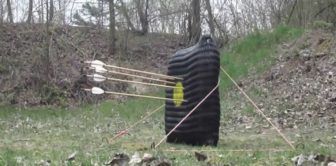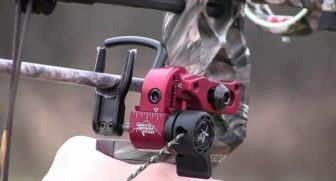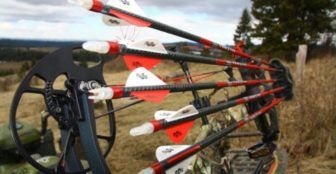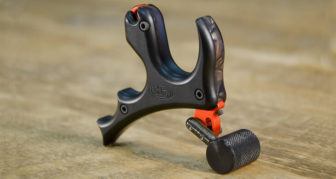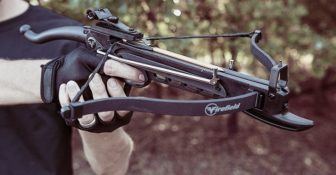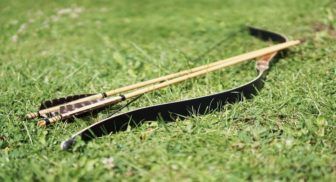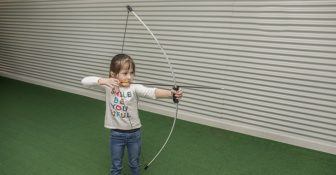4 Types of Bows: Longbow, Recurve Bow, Compound Bow, Crossbow
The choice of a preferred bow is something you'll have to make soon enough in archery. Bows have been in use in human societies as far back as anyone can remember, but developments have led to different types of bows being available.
Each type of bow has its advantages and disadvantages, and for such reasons, it is either favored by a certain group or not.
This review lists all the common types of bows available and takes a closer look at their differences from one another, with the aim of making it easier for you to make the right choice.
The 4 Types of Bows
There are 4 different types of bows in common use. They are:
- The Longbow
- The Recurve Bow
- The Compound Bow
- The Crossbow
1. The Longbow
A longbow is one of the oldest types of bows known to man. It is characterized by being tall and almost as high as its user. The reason for this height is to create a maximum draw force.
Longbows are usually D-shaped in cross-section and do not feature any fancy additions or mechanical systems to increase their draw force.
It's difficult to know how long exactly longbows have been in use by men, but archaeologists uncovered a 1.82-meter longbow in 1991, which was at least 3,000 years old.
Longbows are much quieter than other types of bows and they are the fastest type of bows when it comes to reloading arrows. This made them a favorite among many medieval armies.
Shooting a longbow is also easier than the other bows because there are no expensive accessories like stabilizers , sights, and arrow rests to master shooting with.
A longbow is more forgiving of shooter errors, although it has the lowest level of accuracy among all 4 bow types when it comes to beginners with little archery skills.
Advantages
- Lighter. Longbows are usually lighter than the other bow types because of their simplicity. There are no accessories or fancy additions that could make the bow heavy. Many longbow shooters love longbows for this reason. You can carry them around all day without weighing you down.
- Quicker to prepare. Longbows also have the advantage of being quicker to load and shoot than other bow types. This advantage makes the longbow preferable to the crossbow in many situations where a quick reload is necessary. If you want to shoot and reload very quickly, then the longbow is your best bet.
- Quieter. They're also quieter than other bows, although the difference is often negligible in certain situations.
Disadvantages
- Slower arrow speed. Given their designs, longbows produce less draw force than other bow types, which means that arrows fired from them are slower. At the same draw length, longbows will have less draw weight than the other 3 types of bows.
- Less accurate. Although an experienced archer can get very accurate shots with a longbow, they are generally the least accurate of bow types.
A recurve bow is any bow which has limbs that curve away from the archer when it's unstrung. The purpose of these curvy limbs is to store more energy and make the bow more efficient.
This makes a recurve bow able to shoot higher speed arrows than a traditional bow of the same length. As a result, recurve bows could also be built to be shorter than longbows and they'll still deliver fast arrows.
Hunters who have to wade through thick forests and archers who shoot on horseback prefer the recurve bow to the longbow for this shorter length advantage and versatility.
Modern recurve bows are the only allowed bows for most disciplines in the Olympic games. They may shoot more accurately than longbows, but less accurately than compound bows.
With enough training though, any good archer will make excellently accurate shots using a recurve bow.
Advantages
- Faster than a longbow. At the same draw length, a recurve bow will shoot an arrow faster than a longbow. This is the result of the away-curving limbs, which store draw energy and release it into the arrow once the string gets released.
- More accurate than a longbow. Recurve bows are also more accurate than longbows because of the concentration of movement on the limbs. The riser, which is the part of the bow in the middle between the limbs, and which hosts the arrow rest and sight, remains stable.
- Shorter bow sizes. Since the curving limbs store all the energy, a shorter recurve bow will deliver the same or more force than a longer longbow. This makes the recurve bow more energy-efficient and less cumbersome than a longbow. It's also easier to handle inside a blind when hunting.
Disadvantages
- Noisier shot. Recurve bows are less quiet than longbows because the recurve bow puts more strain on the materials used in making it. Depending on the situation though, this may or may not be important.
A compound bow also has limbs just like a recurve bow, but it uses cables and pulleys as a levering system to bend them and store kinetic energy when being drawn.
The strength of the compound bow lies in this pulley and cam system, which gives the user a mechanical advantage and allows the arrow to remain much stiffer than other arrows because of the high force involved.
This makes the compound bow more energy-efficient and enables it to shoot an arrow faster than longbows and recurve bows . Compound bows also have a higher accuracy than the other 2 bows.
The first compound bow was first developed in 1966 by Wolless Wilbur Allen from Missouri, U.S.A and it has continued to gain popularity around the world since then.
Compound bows are further grouped according to their cam design. A compound bow can either be a single cam, a dual cam, a hybrid cam, or a binary cam system.
Advantages
- Higher accuracy. Compound bows can shoot more accurately than recurve bows and longbows as a result of their design. The 2 limbs of a compound bow get pulled in towards each other when the bow is drawn. This enables the bow to produce lower levels of vibration when the arrow gets fired, than recurve bows and longbows.
- Faster arrows. The arrows are also faster because the compound bow's pulley levering system allows more energy to get stored in its limbs.
- More energy-efficient. Compound bows have a higher energy efficiency than both recurve bows and longbows. This efficiency can get further optimized and either increased or reduced by changing the cam system.
Disadvantages
- More moving parts. When it comes to mechanics, the more moving parts there are, the higher possibilities will exist of a mechanical failure. It also means a more elaborate maintenance routine.
- Requires specialized tools. Unlike say a longbow, compound bows need specialized tools to maintain them.
- Dry firing danger. Firing a compound bow without an arrow is a bad idea.
4. The Crossbow
Photo: instructables.com
A crossbow consists of a horizontal bow which is mounted on a frame and held in the hand like a firearm. It has a long and rich history of use both in hunting and in warfare.
The draw force of a crossbow is higher than that of other types of bows and the frame also holds the drawn string in place until a trigger get pressed to release it and fire the bolt.
Unlike other types of bows, a crossbow requires much less practice and archery skill to make accurate shots. Its bolts are also faster than other bow types.
Many types of crossbows have gotten designed and built around the world through the ages and you can still find them today.
Modern crossbows, however, often come with a scope and the bow part can also be a recurve or a compound bow , increasing its already tremendous draw force.
Advantages
- Higher draw force. Crossbows have the highest on average draw force than other types of bows. Some crossbows are so rigid that an extra instrument is often needed to draw the string.
- It can hold the tension. The second advantage of crossbows over hand bows is that the crossbow can hold the drawn string's tension for as long as you want. Such a feat is impossible with hand bows, where the user's hand will quickly grow tired from drawing and holding the string.
- Little training required. The thing about crossbows is that you just need to point and shoot. Also, given its high-powered nature, this makes it a very deadly weapon.
Disadvantages
- Heavy. As a result of their design, crossbows are the heaviest types of bows. This makes them less preferable to get carried around for extended periods of time.
-
Slower shooting rate.
The second biggest disadvantage of crossbows is that they are the slowest bows to load. In the time it takes you to shoot 6 crossbow bolts, you could have shot 10 longbow arrows.
- Legal Issues. Crossbows have often been banned through the ages. Some jurisdictions still need a license for crossbows today, while others don't. So, always check.
- Dry firing danger. Firing a crossbow without an arrow is a very bad idea.
Conclusion
Coming to the end of our review of the common types of bows available, you should have developed a soft spot for one type of bow or the other by now.
The choice of a bow is a personal decision that everyone must make. And unless you need it for a competition, what matters here is only how you feel and what you really need in your life.
Some folks who love challenges swear by longbows, while others find a compound bow or crossbow challenging enough. In the end, you should follow your heart.
